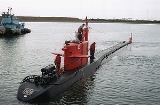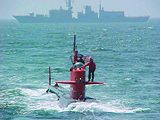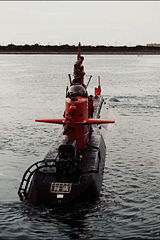
NR-1 Deep Submergence Craft
Encyclopedia
The Deep Submergence Vessel NR-1 was a unique United States Navy
nuclear-powered ocean engineering and research submarine
. It was built by the Electric Boat
Division of General Dynamics
at Groton, Connecticut
. It was launched
on January 25, 1969, completed its initial sea trials August 19, 1969, and is home-ported at Naval Submarine Base New London
. Casually known as "Nerwin", NR-1 was never officially named or commissioned
. The U.S. Navy is allocated a specific number of warships by the U.S. Congress. Admiral
Hyman Rickover not only avoided using one of those allocations, but he also wanted to avoid the oversight that a warship receives from various bureaus.
 Following the loss of the Space Shuttle Challenger
Following the loss of the Space Shuttle Challenger
in 1986, NR-1 was used to search for, identify, and recover critical parts of the Challenger craft. Because it could remain on the sea floor without resurfacing frequently, NR-1 was a major tool for searching deep waters. NR-1 remained submerged and on station even when heavy weather and rough seas hit the area and forced all other search and recovery ships into port.
In 1995, Dr. Robert Ballard
used the NR-1 and its support ship, the MV Carolyn Chouest
, to explore the wreck of the HMHS Britannic
, the sister ship of the RMS Titanic, which struck a mine and sank off the coast of Greece while serving as a hospital ship during World War I.
On February 25, 2007, NR-1, towed by Carolyn Chouest, arrived in Galveston, Texas
, in preparation for an expedition to survey the Flower Garden Banks National Marine Sanctuary
and other sites in the Gulf of Mexico
.
The NR-1 was deactivated on November 21, 2008 at the U.S. Navy submarine base at Groton, Connecticut
, then sent to Puget Sound Naval Shipyard to be scrapped.
 NR-1 had sophisticated electronics, computers and sonar systems that aided in navigation, communications, and object location and identification. It could maneuver or hold a steady position on or close to the seabed or underwater ridges, detect and identify objects at a considerable distance, and lift objects off the ocean floor.
NR-1 had sophisticated electronics, computers and sonar systems that aided in navigation, communications, and object location and identification. It could maneuver or hold a steady position on or close to the seabed or underwater ridges, detect and identify objects at a considerable distance, and lift objects off the ocean floor.
NR-1 was equipped with two electric-motor driven propellers and its maneuverability was enhanced by four ducted thrusters, two in the front and two in the rear. The vehicle had diving planes mounted on the sail, and a conventional rudder.
NR-1 could travel submerged at approximately four knots for long periods, limited only by consumable supplies — primarily food. It could study and map the ocean bottom, including temperature, currents, and other information for military, commercial and scientific uses. Its nuclear propulsion provided independence from surface support ships and essentially unlimited endurance.
NR-1 was generally towed to and from remote mission locations by an accompanying surface tender, which was also capable of conducting research in conjunction with the submarine. NR-1's last mother ship was the MV Carolyn Chouest, which provided towing, communications, berthing and direct mission support for all NR-1 operations. An extremely versatile platform, it was an indispensable member of the NR-1 deep submergence team. The NR-1 command was manned with thirty-five Navy personnel and ten civilian contractor personnel. NR-1 carried as many as thirteen persons (crew and specialists) at one time, including three of the four assigned officers. (The Operations Officer rode on the MV Carolyn Chouest). All personnel that crewed NR-1 were nuclear-trained and specifically screened and interviewed by the Director, Navy Nuclear Propulsion Program
, Admiral Kirkland H. Donald
.
United States Navy
The United States Navy is the naval warfare service branch of the United States Armed Forces and one of the seven uniformed services of the United States. The U.S. Navy is the largest in the world; its battle fleet tonnage is greater than that of the next 13 largest navies combined. The U.S...
nuclear-powered ocean engineering and research submarine
Submarine
A submarine is a watercraft capable of independent operation below the surface of the water. It differs from a submersible, which has more limited underwater capability...
. It was built by the Electric Boat
Electric boat
While a significant majority of water vessels are powered by diesel engines, with sail power and gasoline engines also remaining popular, boats powered by electricity have been used for over 120 years. Electric boats were very popular from the 1880s until the 1920s, when the internal combustion...
Division of General Dynamics
General Dynamics
General Dynamics Corporation is a U.S. defense conglomerate formed by mergers and divestitures, and as of 2008 it is the fifth largest defense contractor in the world. Its headquarters are in West Falls Church , unincorporated Fairfax County, Virginia, in the Falls Church area.The company has...
at Groton, Connecticut
Groton, Connecticut
Groton is a town located on the Thames River in New London County, Connecticut, United States. The population was 39,907 at the 2000 census....
. It was launched
Ship naming and launching
The ceremonies involved in naming and launching naval ships are based in traditions thousands of years old.-Methods of launch:There are three principal methods of conveying a new ship from building site to water, only two of which are called "launching." The oldest, most familiar, and most widely...
on January 25, 1969, completed its initial sea trials August 19, 1969, and is home-ported at Naval Submarine Base New London
Naval Submarine Base New London
Naval Submarine Base New London is the United States Navy's primary submarine base, the "Home of the Submarine Force", and "the Submarine Capital of the World".-History:...
. Casually known as "Nerwin", NR-1 was never officially named or commissioned
Ship commissioning
Ship commissioning is the act or ceremony of placing a ship in active service, and may be regarded as a particular application of the general concepts and practices of project commissioning. The term is most commonly applied to the placing of a warship in active duty with its country's military...
. The U.S. Navy is allocated a specific number of warships by the U.S. Congress. Admiral
Admiral (United States)
In the United States Navy, the United States Coast Guard and the United States Public Health Service Commissioned Corps, admiral is a four-star flag officer rank, with the pay grade of O-10. Admiral ranks above vice admiral and below Fleet Admiral in the Navy; the Coast Guard and the Public Health...
Hyman Rickover not only avoided using one of those allocations, but he also wanted to avoid the oversight that a warship receives from various bureaus.
History
NR-1's missions included search, object recovery, geological survey, oceanographic research, and installation and maintenance of underwater equipment. NR-1's unique capability to remain at one site and completely map or search an area with a high degree of accuracy was a valuable asset on several occasions.
Space Shuttle Challenger
Space Shuttle Challenger was NASA's second Space Shuttle orbiter to be put into service, Columbia having been the first. The shuttle was built by Rockwell International's Space Transportation Systems Division in Downey, California...
in 1986, NR-1 was used to search for, identify, and recover critical parts of the Challenger craft. Because it could remain on the sea floor without resurfacing frequently, NR-1 was a major tool for searching deep waters. NR-1 remained submerged and on station even when heavy weather and rough seas hit the area and forced all other search and recovery ships into port.
In 1995, Dr. Robert Ballard
Robert Ballard
Robert Duane Ballard is a former United States Navy officer and a professor of oceanography at the University of Rhode Island who is most noted for his work in underwater archaeology. He is most famous for the discoveries of the wrecks of the RMS Titanic in 1985, the battleship Bismarck in 1989,...
used the NR-1 and its support ship, the MV Carolyn Chouest
MV Carolyn Chouest
MV Carolyn Chouest is a chartered submarine support ship for the U.S. Navy assigned to the Special Missions Program to support the NR-1 Deep Submergence Craft...
, to explore the wreck of the HMHS Britannic
HMHS Britannic
HMHS Britannic was the third and largest of the White Star Line. She was the sister ship of and , and was intended to enter service as a transatlantic passenger liner. She was launched just before the start of the First World War and was laid up at her builders in Belfast for many months before...
, the sister ship of the RMS Titanic, which struck a mine and sank off the coast of Greece while serving as a hospital ship during World War I.
On February 25, 2007, NR-1, towed by Carolyn Chouest, arrived in Galveston, Texas
Galveston, Texas
Galveston is a coastal city located on Galveston Island in the U.S. state of Texas. , the city had a total population of 47,743 within an area of...
, in preparation for an expedition to survey the Flower Garden Banks National Marine Sanctuary
Flower Garden Banks National Marine Sanctuary
The Flower Garden Banks is a U.S. National Marine Sanctuary in the northwestern Gulf of Mexico, located roughly 105 miles south of Sabine Pass, Texas....
and other sites in the Gulf of Mexico
Gulf of Mexico
The Gulf of Mexico is a partially landlocked ocean basin largely surrounded by the North American continent and the island of Cuba. It is bounded on the northeast, north and northwest by the Gulf Coast of the United States, on the southwest and south by Mexico, and on the southeast by Cuba. In...
.
The NR-1 was deactivated on November 21, 2008 at the U.S. Navy submarine base at Groton, Connecticut
Groton, Connecticut
Groton is a town located on the Thames River in New London County, Connecticut, United States. The population was 39,907 at the 2000 census....
, then sent to Puget Sound Naval Shipyard to be scrapped.
Capabilities
The NR-1 performed underwater search and recovery, oceanographic research missions and installation and maintenance of underwater equipment to a depth of almost half a nautical mile. Its features included extending bottoming wheels, three viewing ports, exterior lighting, television and still cameras for color photographic studies, an object recovery claw, a manipulator that could be fitted with various gripping and cutting tools and a work basket that could be used in conjunction with the manipulator to deposit or recover items in the sea. Surface vision was provided by a television periscope permanently installed on a fixed mast its her sail area.
NR-1 was equipped with two electric-motor driven propellers and its maneuverability was enhanced by four ducted thrusters, two in the front and two in the rear. The vehicle had diving planes mounted on the sail, and a conventional rudder.
NR-1 could travel submerged at approximately four knots for long periods, limited only by consumable supplies — primarily food. It could study and map the ocean bottom, including temperature, currents, and other information for military, commercial and scientific uses. Its nuclear propulsion provided independence from surface support ships and essentially unlimited endurance.
NR-1 was generally towed to and from remote mission locations by an accompanying surface tender, which was also capable of conducting research in conjunction with the submarine. NR-1's last mother ship was the MV Carolyn Chouest, which provided towing, communications, berthing and direct mission support for all NR-1 operations. An extremely versatile platform, it was an indispensable member of the NR-1 deep submergence team. The NR-1 command was manned with thirty-five Navy personnel and ten civilian contractor personnel. NR-1 carried as many as thirteen persons (crew and specialists) at one time, including three of the four assigned officers. (The Operations Officer rode on the MV Carolyn Chouest). All personnel that crewed NR-1 were nuclear-trained and specifically screened and interviewed by the Director, Navy Nuclear Propulsion Program
Naval Reactors
Naval Reactors is an umbrella term for the U.S. government office that has comprehensive responsibility for the continued safe and reliable operation of the United States Navy's nuclear propulsion program and thus for United States Naval reactors...
, Admiral Kirkland H. Donald
Kirkland H. Donald
Kirkland Hogue Donald is a United States Navy Admiral who serves as the current Director, Naval Nuclear Propulsion and Deputy Administrator, National Nuclear Security Administration's Naval Reactors. He previously served as Commander, Submarine Force, U.S. Atlantic Fleet, and Commander, Submarine...
.

